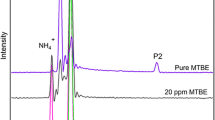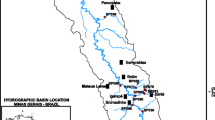Abstract
Dichlorodiphenyl trichloroethane (DDT) as an organochlorine compound has been globally used as a pesticide for controlling soil-dwelling insects and treating diseases such as malaria and typhus. The degradation products of DDT and its metabolites have also negative effects on the environment. The present study has investigated the determination of DDT and its metabolites in water sample using ion mobility spectrometry (IMS) as a rapid and sensitive detection technique. For this purpose, DDT and its metabolites were extracted using reverse phase solid-phase extraction (SPE) from water samples. The samples were then recovered by eluting with methanol and finally, quantified using the corona discharge IMS technique. Injection and oven temperatures and the effect of dopant were optimized as experimental parameters influencing both detection and determination efficiencies. Degradation of DDT in IMS drift tube was studied and reduced mobility values of DDT and its metabolites were calculated. The developed method was validated using water sample to obtain good results for the determination of DDT at low levels (1 ng ml−1) while spiked recoveries were obtained to be between 95.0–96.7%. The proposed method based on IMS proved to be a simple, inexpensive, rapid and sensitive procedure for the fast monitoring and determination of DDT and its main metabolites in water sample.





Similar content being viewed by others
References
W. H. Organization (1979) DDT and its derivatives, Environmental Health Criteria monograph No. 009. World Health Organization, Geneva, ISBN 92-4-154069-9
Doong RA, Peng CK, Sun YC, Liao PL (2002) Composition and distribution of organochlorine pesticide residues in surface sediments from the Wu-Shi River estuary. Mar Pollut Bull 45:246–253
Yang X, Wang S, Bian Y, Chen F, Yu G, Gu C, Jiang X (2008) Dicofol application resulted in high DDTs residue in cotton fields from northern Jiangsu province, China. J Hazard Mater 150:92–98
Elango A, Shepherd B, Chen TT (2006) Effects of endocrine disrupters on the expression of growth hormone and prolactin mRNA in the rainbow trout pituitary. Gen Comp Endocrinol 145:116–127
Zhang Z, Hong H, Zhou J, Huang J, Yu G (2003) Fate and assessment of persistent organic pollutants in water and sediment from Minjiang River Estuary, Southeast China. Chemosphere 52:1423–1430
Li XH, Wang W, Wang J, Cao XL, Wang XF, Liu JC, Liu XF, Xu XB, Jiang XN (2008) Contamination of soils with organochlorine pesticides in urban parks in Beijing, China. Chemosphere 70:1660–1668
Wong F, Robson M, Diamond M, Harrad S, Truong J (2009) Concentrations and chiral signatures of POPs in soils and sediments: a comparative urban versus rural study in Canada and UK. Chemosphere 74:404–411
Baloch UK, Haseeb M (1996) Persistent pesticide pollutants in crop protection, Risk Reduction: Chemicals and Energy into the 21st Century. Taylor & Francis, London, UK
Engelmann MD, Hutcheson R, Henschied K, Neal R, Cheng IF (2003) Simultaneous determination of total polychlorinated biphenyl and dichlorodiphenyltrichloroethane (DDT) by dechlorination with Fe/Pd and Mg/Pd bimetallic particles and flame ionization detection gas chromatography. Microchem J 74:19–25
Basheer C, Lee HK, Obbard JP (2002) Determination of organochlorine pesticides in seawater using liquid-phase hollow fibre membrane microextraction and gas chromatography–mass spectrometry. J Chromatogr A 968:191–199
Li HP, Li GC, Jen JF (2003) Determination of organochlorine pesticides in water using microwave assisted headspace solid-phase microextraction and gas chromatography. J Chromatogr A 1012:129–137
Zhou Q, Xiao J, Wang W (2006) Using multi-walled carbon nanotubes as solid phase extraction adsorbents to determine dichlorodiphenyltrichloroethane and its metabolites at trace level in water samples by high performance liquid chromatography with UV detection. J Chromatogr A 1125:152–158
Baugros JB, Giroud B, Dessalces G, Grenier-Loustalot MF, Cren-Olivé C (2008) Multiresidue analytical methods for the ultra-trace quantification of 33 priority substances present in the list of REACH in real water samples. Anal Chim Acta 607:191–203
Valsamaki V, Boti V, SakkasV ATA (2006) Determination of organochlorine pesticides and polychlorinated biphenyls in chicken eggs by matrix solid phase dispersion. Anal Chim Acta 573:195–201
Zhou YY, Wang SW, Kim KN, Li JH, Yan XP (2006) Evaluation of expanded graphite as on-line solid-phase extraction sorbent for high performance liquid chromatographic determination of trace levels of DDTs in water samples. Talanta 69:970–975
Campillo N, Penalver R, Hernández-Córdoba M (2007) Pesticide analysis in herbal infusions by solid-phase microextraction and gas chromatography with atomic emission detection. Talanta 71:1417–1423
Carvalho PN, Rodrigues PNR, Alves F, Evangelista R, Basto MCP, Vasconcelos MTS (2008) An expeditious method for the determination of organochlorine pesticides residues in estuarine sediments using microwave assisted pre-extraction and automated headspace solid-phase microextraction coupled to gas chromatography–mass spectrometry. Talanta 76:1124–1129
Ji J, Deng C, Zhang H, Wu Y, Zhang X (2007) Microwave-assisted steam distillation for the determination of organochlorine pesticides and pyrethroids in Chinese teas. Talanta 71:1068–1074
Basheer C, Balasubramanian R, Lee HK (2003) Determination of organic micropollutants in rainwater using hollow fiber membrane/liquid-phase microextraction combined with gas chromatography–mass spectrometry. J Chromatogr A 1016:1120–1125
Gfrerer M, Lankmayr E (2005) DDT degradation during enhanced solid–liquid extractions: A consideration. J Chromatogr A 1072:117–125
Creaser CS, Griffiths JR, Bramwell CJ, Noreen S, Hill CA, Thomas CP (2004) Ion mobility spectrometry: a review. Part 1. Structural analysis by mobility measurement. Analyst 129:984–994
Eiceman GA, Karpas Z, Hill HH Jr (2013) Ion mobility spectrometry, 3rd edn. CRC press, Taylor & Francis Group, New York
Khayamian T, Tabrizchi M, Jafari M (2003) Analysis of 2, 4, 6-trinitrotoluene, pentaerythritol tetranitrate and cyclo-1, 3, 5-trimethylene-2, 4, 6-trinitramine using negative corona discharge ion mobility spectrometry. Talanta 59:327–333
Sheibani A, Tabrizchi M, Ghaziaskar HS (2008) Determination of aflatoxins B1 and B2 using ion mobility spectrometry. Talanta 75:233–238
Keller T, Keller A, Tutsch-Bauer E, Monticelli F (2006) Application of ion mobility spectrometry in cases of forensic interest. Forensic Sci Int 161:130–140
Tabrizchi M, KhayamianT TN (2000) Design and optimization of a corona discharge ionization source for ion mobility spectrometry. Rev Sci Instrum 71:2321–2328
Tabrizchi M (2001) Temperature corrections for ion mobility spectrometry. Appl Spectrosc 55:1653–1659
Zhao Y, Yi X, Zhang M, Liu L, Ma W (2010) Fundamental study of degradation of dichlorodiphenyltrichloroethane in soil by laccase from white rot fungi. Int J Environ Sci Technol 7:359–366
Chauhan A, Singh J (2015) Biodegradation of DDT. J Text Sci Eng 5:183
Eganhouse RP, DiFilippo EL (2015) Determination of 1-chloro-4-[2, 2, 2-trichloro-1-(4-chlorophenyl) ethyl] benzene and related compounds in marine pore water by automated thermal desorption-gas chromatography/mass spectrometry using disposable optical fiber. J Chromatogr A 1415:38–47
Mauriz E, Calle A, Manclús J, Montoya A, Hildebrandt A, Barceló D, Lechuga LM (2007) Optical immunosensor for fast and sensitive detection of DDT and related compounds in river water samples. Biosens Bioelectron 22:1410–1418
Mekonen S, Lachat C, Ambelu A, Steurbaut W, Kolsteren P, Jacxsens L, Wondafrash M, Houbraken M, Spanoghe P (2015) Risk of DDT residue in maize consumed by infants as complementary diet in southwest Ethiopia. Sci Total Environ 511:454–460
Acknowledgements
The authors gratefully acknowledge the financial support from the Research Council of Alzahra University. The authors also acknowledge Dr. Vahideh Ilbeigy for her invaluable assistance.
Author information
Authors and Affiliations
Corresponding author
Rights and permissions
About this article
Cite this article
Mohammadnejad, M., Farhadpour, M., Mahdavi, V. et al. Rapid monitoring and sensitive determination of DDT and its metabolites in water sample using solid-phase extraction followed by ion mobility spectrometry. Int. J. Ion Mobil. Spec. 20, 23–30 (2017). https://doi.org/10.1007/s12127-016-0211-6
Received:
Revised:
Accepted:
Published:
Issue Date:
DOI: https://doi.org/10.1007/s12127-016-0211-6




